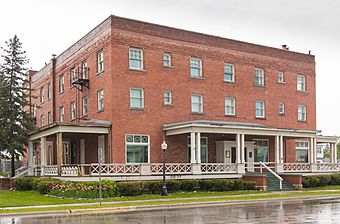Wolverine Hotel (Boyne City, Michigan) facts for kids
The Wolverine Hotel, also known as the Dilworth Hotel, is a historic building in Boyne City, Michigan. You can find it at 300 Water Street. This hotel was added to the National Register of Historic Places in 1986. It's special because it's the only hotel left in the Boyne area from the early 1900s, when Boyne City was a busy lumber town.
Quick facts for kids |
|
|
Wolverine Hotel
|
|
 |
|
| Location | 300 Water St., Boyne City, Michigan |
|---|---|
| Area | 0.8 acres (0.32 ha) |
| Built | 1911 |
| Built by | Price Bros. |
| Architectural style | Classical Revival |
| NRHP reference No. | 86000261 |
| Added to NRHP | February 13, 1986 |
Contents
A Look Back: The Hotel's History
Boyne City's Lumber Boom
Around the year 1900, Boyne City was a very important place for the lumber industry in northwest Michigan. Many businesses related to cutting and selling timber opened here. This created lots of jobs, and more and more people moved to the city.
Boyne City grew super fast! In 1900, only 912 people lived there. But by 1910, the population had jumped to almost 6,000 residents. It was a really exciting time for the city.
Building the Wolverine Hotel
By 1911, Boyne City already had several hotels. However, a group of 46 local residents thought the city needed an even fancier hotel. They wanted a place that was a step above the rest.
So, these residents formed a group called the Boyne City Hotel Company. They decided to build a new hotel and call it the Wolverine Hotel. They hired a company called Price Brothers from East Jordan, Michigan to build it. The grand opening for the Wolverine Hotel was on February 1, 1912.
Changes Over the Years
After World War I, things started to change for Boyne City. Most of the timber in the area had been cut down. This meant many businesses closed, and people started to move away from the city.
In 1936, a man named Wesley Dilworth bought the hotel. He decided to change its name to the Dilworth Hotel. During the 1930s and 1940s, the Dilworth Hotel became famous across the country. It was known for hosting the yearly Boyne City Smelt Run Banquet, a big event.
Wesley Dilworth sold the hotel in the mid-1940s. After that, the hotel had many different owners. By the 2000s, it was having a tough time and eventually closed in 2008.
A New Beginning
In 2013, an investor bought the building with plans to fix it up. This project got a big grant of $1,000,000 in 2015. When the work is finished, the hotel will have 26 rooms for guests. It will also have a restaurant, a banquet room for events, and a pub.
What Does the Hotel Look Like?
The Wolverine Hotel is a four-story building made of brick. It has a flat roof and is designed in a style called Classical Revival. This style often uses ideas from ancient Greek and Roman buildings.
The bottom two floors of the hotel are shaped like a rectangle. The top two floors are shaped like a "U". The building is made of red-orange bricks. You can see small white concrete blocks decorating the windows on the third floor. There's also a metal trim, called a cornice, that goes around the building above the fourth-floor windows.
Porches and Pillars
The hotel has three porches on its north, east, and west sides. These porches have square pillars, called Doric columns. These porches are new versions of the original ones, which were taken off the building a long time ago.
Inside the Hotel
When you step inside the lobby, you'll see decorative pillars sticking out from the walls. The ceiling is special, with a pattern of beams and square sections called coffers. It also has fancy plaster designs. The wood inside is dark oak, and the floor is made of porcelain tiles.
These tiles continue down the hallway to the main dining room. The dining room also has similar pillars and a coffered ceiling. You'll find glass chandeliers hanging from the ceiling and a large fireplace. There's another dining area or bar in one corner of the building, with the kitchen across from it. A small addition was built to the hotel to make the kitchen bigger for freezers and coolers.



